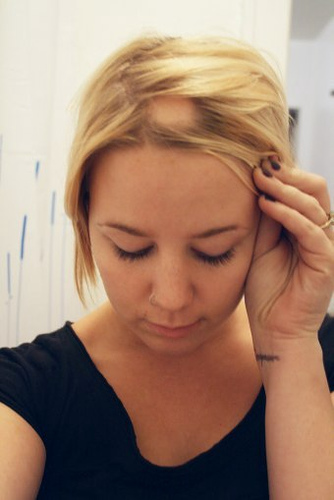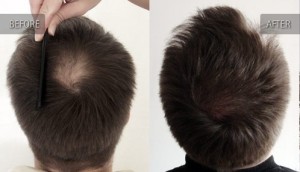Tests and Exams
Female pattern baldness is usually diagnosed based on:
- Ruling out other causes of hair loss
- The appearance and pattern of hair loss
- Your medical history
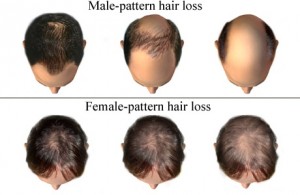 The doctor will examine you for other signs of too much male hormone (androgen), such as:
The doctor will examine you for other signs of too much male hormone (androgen), such as:
- Abnormal new hair growth, such as on the face or between the belly button and pubic area.
- Changes in menstrual periods and enlargement of the clitoris
- New acne
A skin biopsy or other procedures or blood tests may be used to diagnose skin disorders that cause hair loss.
Analyzing the hair itself does not accurately diagnose nutritional or similar causes of hair loss, although it may reveal substances such as arsenic or lead.
Treatment of Female pattern baldness
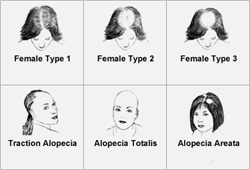 The hair loss in female pattern baldness is permanent, if not treated. In most cases, hair loss is mild to moderate. You do not need treatment if you are comfortable with your appearance.
The hair loss in female pattern baldness is permanent, if not treated. In most cases, hair loss is mild to moderate. You do not need treatment if you are comfortable with your appearance.
The only drug or medication approved by the United States Food and Drug Administration (FDA) to treat female pattern baldness is minoxidil, used on the scalp.
- For women, the 2% concentration is recommended.
- Minoxidil may help hair grow in 20% to 25% of women. In most women it may slow or stop hair loss.
- Treatment is expensive, because you must continue to use the medication. Hair loss starts again when you stop using minoxidil.
In women who do not respond to minoxidil, oral spironolactone may be added.
- Spironolactone may help women whose hair loss is caused by too much male hormones (androgens). This drug is not FDA-approved for female baldness.
- It can cause increased potassium levels in the blood, and cannot be used in people with kidney failure or who are pregnant.
Hair transplants remove tiny plugs of hair from areas where hair is thicker, and place them in areas that are balding. This can cause minor scarring where the hair is removed, and carries a slight risk for skin infection. Many transplantation sessions are usually needed, which can be expensive. However, the results are often excellent and permanent.
The use of hair implants made of artificial fibers was banned by the FDA because of the high rate of infection.
Stitching (suturing) hair pieces to the scalp is not recommended. It can result in scars, infections, and abscess of the scalp.
Hair weaving, hairpieces, or a change in hairstyle may disguise hair loss and improve your appearance. This is often the least expensive and safest way to deal with female pattern baldness.
Prognosis (Outlook)
Female pattern baldness usually does not mean that a woman has a medical disorder. However, for many women, it may affect self-esteem or cause anxiety. The hair loss is usually permanent.
Potential Complications
Complications are psychological stress and a loss of self-esteem due to change in appearance.
When to Contact a Health Professional
Call your health care provider if you experience hair loss and it continues, especially if you also have itching, skin irritation, or other symptoms. There might be a treatable medical cause for the hair loss.
Male pattern baldness
Alternative Names: Alopecia in men; Baldness – male; Hair loss in men; Androgenetic alopecia
Male pattern baldness is the most common type of hair loss in men.
Causes of Male pattern baldness
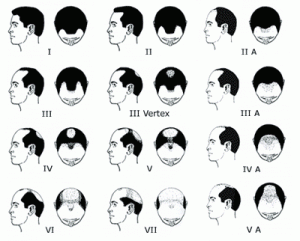 Male pattern baldness is related to your genes and male sex hormones. It usually follows a pattern of receding hairline and hair thinning on the crown, and is caused by hormones and genetic predisposition.
Male pattern baldness is related to your genes and male sex hormones. It usually follows a pattern of receding hairline and hair thinning on the crown, and is caused by hormones and genetic predisposition.
Each strand of hair you have sits in a tiny hole (cavity) in the skin called a follicle. Baldness in general occurs when the hair follicle shrinks over time, resulting in shorter and finer hair. Eventually, the follicle does not grow a new hair. However, the follicles remain alive, which suggest that it’s possible to grow new hair.
Male pattern baldness Symptoms
The typical pattern of male baldness begins at the hairline. The hairline gradually moves backward (recedes) and forms an “M” shape. Eventually the hair becomes finer, shorter, and thinner, and creates a U-shaped (or horseshoe) pattern of hair around the sides of the head.
Tests and Exams
Classic male pattern baldness is usually diagnosed based on the appearance and pattern of the hair loss.
It is important to note that hair loss may be due to other conditions. This may be true if your hair loss occurs in patches, you shed a lot of hair, your hair breaks, or you have hair loss along with redness, scaling, or pain.
A skin biopsy or other procedures may be needed to diagnose other disorders that cause hair loss.
Hair analysis is not accurate for diagnosing hair loss due to nutritional or similar disorders. However, it may reveal substances such as arsenic or lead.
Treatment of Male pattern baldness
Treatment is not necessary if you are comfortable with your appearance. Hair weaving, hairpieces, or change of hairstyle may disguise the hair loss. This is usually the least expensive and safest approach for male baldness.
Two medications are approved to treat male pattern baldness:
- Minoxidil (Rogaine) is a solution that you apply directly to the scalp to stimulate the hair follicles. It slows hair loss for many men, and some men grow new hair. Hair loss returns when you stop using this medicine.
- Finasteride (Propecia, Proscar) is a pill that interferes with the production of a certain male hormone linked to baldness. It slows hair loss. It works a bit better than minoxidil. Hair loss returns when you stop using this medicine.
Hair transplants consist of removing tiny plugs of hair from areas where the hair is continuing to grow and placing them in areas that are balding. This can cause minor scarring and possibly, infection. The procedure usually requires multiple sessions and may be expensive. Results, however, are often excellent and permanent.
Suturing hair pieces to the scalp is not recommended. It can result in scars, infections, and abscess of the scalp. The use of hair implants made of artificial fibers was banned by the FDA because of the high rate of infection.
Prognosis (Outlook)
Male pattern baldness does not indicate a medical disorder, but it may affect self-esteem or cause anxiety. The hair loss is usually permanent.
Potential Complications
- Psychological stress
- Loss of self-esteem due to change in appearance
When to Contact a Health Professional
Call your doctor if:
- Your hair loss occurs in an atypical pattern, including rapid hair loss, widespread shedding, hair loss in patches, or hair breakage.
- Your hair loss occurs with itching, skin irritation, redness, scaling, pain, or other symptoms.
- Your hair loss begins after starting a medication.
- You want to attempt to treat your hair loss.
